Cylinder Head -- Inspection |
| 1. CLEAN CYLINDER HEAD SUB-ASSEMBLY |
 |
Clean the cylinder head.
Using a gasket scraper, remove all the gasket material from the cylinder block contact surface.
- NOTICE:
- Be careful not to scratch the cylinder block contact surface.
Using a wire brush, remove all the carbon from the combustion chambers.
- NOTICE:
- Be careful not to scratch the cylinder block contact surface.
 |
Using a valve guide bushing brush and solvent, clean all the guide bushes.
 |
Using a soft brush and solvent, thoroughly clean the cylinder head.
 |
| 2. INSPECT CYLINDER HEAD SUB-ASSEMBLY |
 |
Inspect the cylinder head for warpage.
Using a precision straightedge and feeler gauge, measure the surfaces contacting the cylinder block and the manifolds for warpage.
- Maximum warpage:
- 0.15 mm (0.005 in.)
Inspect the cylinder head for cracks.
Using a dye penetrant, check the combustion chamber, intake ports, exhaust ports and cylinder block surface for cracks.
If cracked, replace the cylinder head.
 |
| 3. CLEAN INTAKE VALVE |
 |
Using a gasket scraper, chip off any carbon from the valve head.
Using a wire brush, thoroughly clean the valve.
| 4. INSPECT INTAKE VALVE |
 |
Using a micrometer, measure the diameter of the valve stem.
- Standard valve stem diameter:
- 5.970 to 5.985 mm (0.2350 to 0.2356 in.)
Check the valve face angle.
Grind the valve enough to remove pits and carbon.
Check that the valve is ground to the correct valve face angle.
- Standard valve face angle:
- 44.5°
 |
Check the valve head margin thickness.
- Standard margin thickness:
- 1.1 mm (0.043 in.)
- Minimum margin thickness:
- 0.6 mm (0.024 in.)
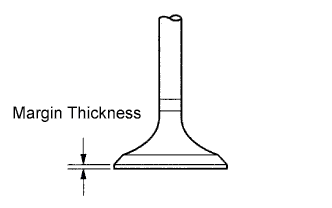 |
Check the valve overall length.
- Standard overall length:
- 105.15 to 105.75 mm (4.1398 to 4.1634 in.)
- Minimum overall length:
- 104.65 mm (4.1201 in.)
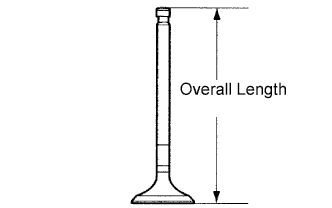 |
Check the surface of the valve stem tip for wear.
If the valve stem tip is worn, resurface the tip with a grinder or replace the valve.- NOTICE:
- Do not grind off more than the minimum.
 |
| 5. CLEAN EXHAUST VALVE |
 |
Using a gasket scraper, chip off any carbon from the valve head.
Using a wire brush, thoroughly clean the valve.
| 6. INSPECT EXHAUST VALVE |
 |
Using a micrometer, measure the diameter of the valve stem.
- Standard valve stem diameter:
- 5.960 to 5.975 mm (0.2346 to 0.2352 in.)
Check the valve face angle.
Grind the valve enough to remove pits and carbon.
Check that the valve is ground to the correct valve face angle.
- Standard valve face angle:
- 44.5°
 |
Check the valve head margin thickness.
- Standard margin thickness:
- 1.2 mm (0.047 in.)
- Minimum margin thickness:
- 0.7 mm (0.028 in.)
 |
Check the valve overall length.
- Standard overall length:
- 105.02 to 105.62 mm (4.1347 to 4.1583 in.)
- Minimum overall length:
- 104.52 mm (4.1150 in.)
 |
Check the surface of the valve stem tip for wear.
If the valve stem tip is worn, resurface the tip with a grinder or replace the valve.- NOTICE:
- Do not grind off more than the minimum.
 |
| 7. INSPECT COMPRESSION SPRING |
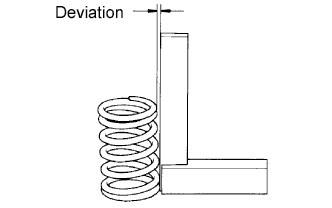 |
Using a steel square, measure the deviation of the spring.
- Maximum deviation:
- 2.0 mm (0.079 in.)
Using a vernier caliper, measure the free length of the spring.
- Standard free length:
Blue Mark None 46.8 mm (1.843 in.) 46.5 mm (1.831 in.)
 |
Using a spring tester, measure the tension of the valve spring at the specified installed length.
- Standard installed tension (at 33.1 mm (1.303 in.)):
Blue Mark None 149.9 to 166.1 N (15.3 to 16.9 kgf, 33.7 to 37.3 lbf) 150.2 to 165.8 N (15.3 to 16.9 kgf, 33.7 to 37.3 lbf)
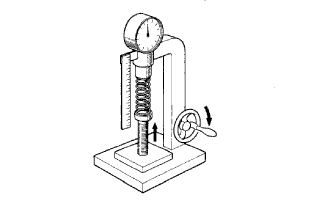 |
| 8. INSPECT INTAKE VALVE GUIDE BUSH |
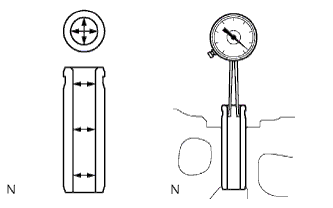 |
Using a caliper gauge, measure the inside diameter of the guide bush.
- Standard bush inside diameter:
- 6.010 to 6.030 mm (0.2366 to 0.2374 in.)
Subtract the valve stem diameter measurement from the guide bush inside diameter measurement.
- Standard oil clearance:
- 0.035 to 0.070 mm (0.0014 to 0.0028 in.)
- Maximum oil clearance:
- 0.10 mm (0.0039 in.)
| 9. INSPECT EXHAUST VALVE GUIDE BUSH |
 |
Using a caliper gauge, measure the inside diameter of the guide bush.
- Standard bush inside diameter:
- 6.010 to 6.030 mm (0.2366 to 0.2374 in.)
Subtract the valve stem diameter measurement from the guide bush inside diameter measurement.
- Standard oil clearance:
- 0.025 to 0.060 mm (0.0009 to 0.0023 in.)
- Maximum oil clearance:
- 0.08 mm (0.0031 in.)
| 10. INSPECT INTAKE VALVE SEAT |
 |
Using a 45° carbide cutter, resurface the valve seats. Remove only enough metal to clean the seats.
Apply a light coat of Prussian blue (or white lead) to the valve face.
 |
Lightly press the valve against the seat. Do not rotate the valve.
Check the valve face and seat for the following:
If blue appears 360° around the face, the valve is concentric. If not, replace the valve.
If blue appears 360° around the valve seat, the guide and face are concentric. If not, resurface the seat.
Check that the seat contact is in the middle of the valve face with the width below.
- Standard width:
- 1.2 to 1.6 mm (0.047 to 0.063 in.)
| 11. INSPECT EXHAUST VALVE SEAT |
 |
Using a 45° carbide cutter, resurface the valve seats. Remove only enough metal to clean the seats.
Apply a light coat of Prussian blue (or white lead) to the valve face.
 |
Lightly press the valve against the seat. Do not rotate the valve.
Check the valve face and seat for the following:
If blue appears 360° around the face, the valve is concentric. If not, replace the valve.
If blue appears 360° around the valve seat, the guide and face are concentric. If not, resurface the seat.
Check that the seat contact is in the middle of the valve face with the width below.
- Standard width:
- 1.6 to 2.0 mm (0.063 to 0.079 in.)
| 12. INSPECT VALVE LIFTER |
 |
Using a micrometer, measure the lifter diameter.
- Standard lifter diameter:
- 30.966 to 30.976 mm (1.2191 to 1.2195 in.)
Using a caliper gauge, measure the lifter bore diameter of the cylinder head.
- Standard lifter bore diameter:
- 31.000 to 31.021 mm (1.2205 to 1.2213 in.)
 |
Measure the oil clearance by subtracting the lifter diameter measurement from the lifter bore diameter measurement.
- Standard oil clearance:
- 0.024 to 0.055 mm (0.0009 to 0.0022 in.)
- Maximum oil clearance:
- 0.075 mm (0.0030 in.)
| 13. INSPECT CYLINDER HEAD SET BOLT |
 |
Using a vernier caliper, measure the minimum outside diameter of the compressed thread at the measuring point A.
- Standard outside diameter:
- 11.8 to 12.0 mm (0.465 to 0.472 in.)
- Minimum outside diameter:
- 11.6 mm (0.457 in.)
| 14. INSPECT CAMSHAFT |
 |
Inspect the circle runout.
Place the camshaft on V-blocks.
Using a dial indicator, measure the circle runout at the center journal.
- Maximum circle runout:
- 0.03 mm (0.0012 in.)
Inspect the cam lobe height.
Using a micrometer, measure the cam lobe height.
- Standard cam lobe height:
- 47.180 to 47.280 mm (1.8575 to 1.8614 in.)
- Minimum cam lobe height:
- 46.76 mm (1.8409 in.)
 |
Inspect the journal diameter of the camshaft.
Using a micrometer, measure the journal diameter of the camshaft for the camshaft bearing.
- Standard journal diameter:
- 27.969 to 27.985 mm (1.1011 to 1.1018 in.)
 |
Check the oil clearance.
Clean the bearing caps and journals.
Check the bearings for flaking and scoring.
If the bearings are damaged, replace the bearing caps and cylinder head as a set.Install the bearings to the bearing caps and cylinder head.
Place the camshaft on the cylinder head.
Lay a strip of Plastigage across each of the journals.
Install the bearing caps.
- NOTICE:
- Do not turn the camshaft.
Remove the bearing caps.
Measure the Plastigage at its widest point.
- Standard oil clearance:
- 0.025 to 0.062 mm (0.0010 to 0.0024 in.)
- Maximum oil clearance:
- 0.10 mm (0.0039 in.)
Completely remove the Plastigage.
Remove the camshaft.

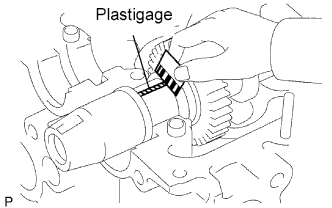
 |
Check the thrust clearance.
Install the camshaft.
Using a dial indicator, measure the thrust clearance while moving the camshaft back and forth.
- Standard thrust clearance:
- 0.035 to 0.185 mm (0.014 to 0.073 in.)
- Maximum thrust clearance:
- 0.25 mm (0.0098 in.)
 |
Using a dial indicator, measure the backlash.
Install the 2 camshafts.
Using a dial indicator, measure the backlash.
- Standard backlash:
- 0.035 to 0.089 mm (0.0014 to 0.0035 in.)
- Maximum backlash:
- 0.189 mm (0.0074 in.)
Remove the 2 camshafts.
 |
| 15. INSPECT NO. 2 CAMSHAFT |
 |
Inspect the circle runout.
Place the camshaft on V-blocks.
Using a dial indicator, measure the circle runout at the center journal.
- Maximum circle runout:
- 0.03 mm (0.0012 in.)
Inspect the cam lobe height.
Using a micrometer, measure the cam lobe height.
- Standard cam lobe height:
- 48.070 to 48.170 mm (1.8925 to 1.8965 in.)
- Minimum cam lobe height:
- 47.92 mm (1.8866 in.)
 |
Inspect the journal diameter of the camshaft.
Using a micrometer, measure the journal diameter of the camshaft for the camshaft bearing.
- Standard journal diameter:
- 27.969 to 27.985 mm (1.1011 to 1.1018 in.)
 |
Check the oil clearance.
Clean the bearing caps and journals.
Check the bearings for flaking and scoring.
If the bearings are damaged, replace the bearing caps and cylinder head.Install the bearings to the bearing caps and cylinder head.
Place the camshaft on the cylinder head.
Lay a strip of Plastigage across each of the journals.
Install the bearing caps.
- NOTICE:
- Do not turn the camshaft.
Remove the bearing caps.
Measure the Plastigage at its widest point.
- Standard oil clearance:
- 0.025 to 0.062 mm (0.0010 to 0.0024 in.)
- Maximum oil clearance:
- 0.10 mm (0.0039 in.)
Completely remove the Plastigage.
Remove the camshaft.

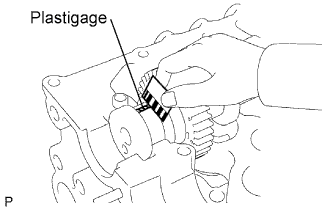
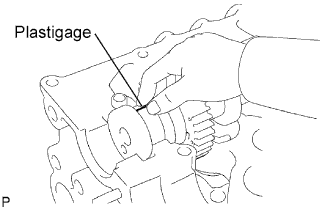 |
Check the thrust clearance.
Install the camshaft.
Using a dial indicator, measure the thrust clearance while moving the camshaft back and forth.
- Standard thrust clearance:
- 0.035 to 0.185 mm (0.0014 to 0.0073 in.)
- Maximum thrust clearance:
- 0.25 mm (0.0098 in.)
 |